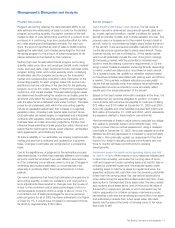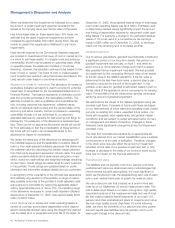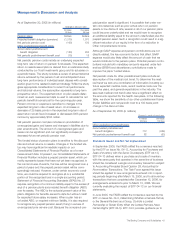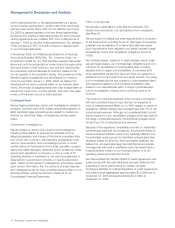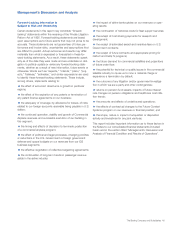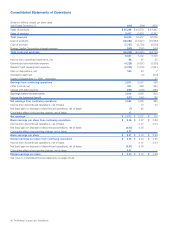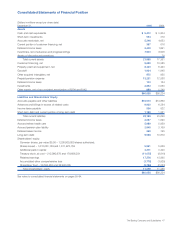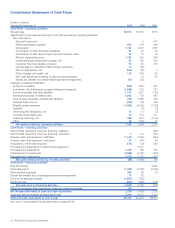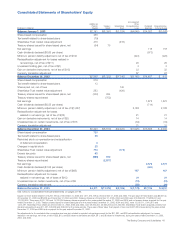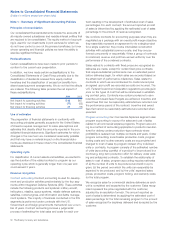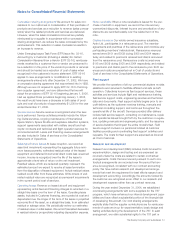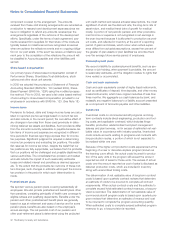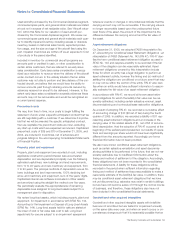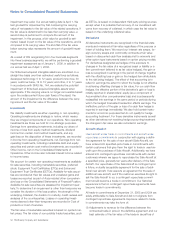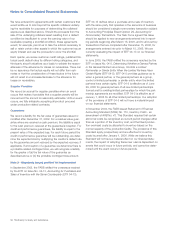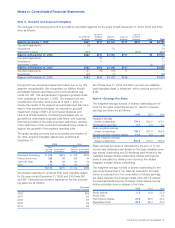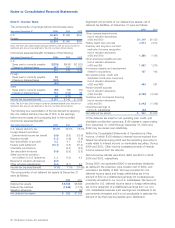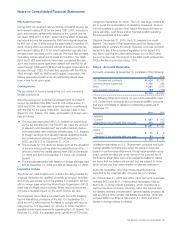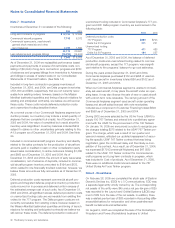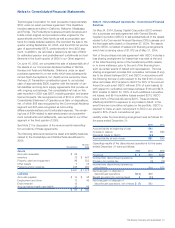Boeing 2005 Annual Report Download - page 53
Download and view the complete annual report
Please find page 53 of the 2005 Boeing annual report below. You can navigate through the pages in the report by either clicking on the pages listed below, or by using the keyword search tool below to find specific information within the annual report.Notes to Consolidated Financial Statements
Concession sharing arrangements We account for sales con-
cessions to our customers in consideration of their purchase of
products and services as a reduction to revenue (sales conces-
sions) when the related products and services are delivered.
However, when the sales concessions incurred are partially
reimbursed by a supplier in accordance with a concession
sharing arrangement, we reduce the sales concessions by the
reimbursement. This reduction in sales concessions results in
an increase to revenue.
Under Emerging Issues Task Force (EITF) Issue No. 02-16,
Accounting by a Customer (including a reseller) for Certain
Consideration Received from a Vendor (EITF 02-16), reimburse-
ments received by a customer from a vendor are presumed to
be a reduction in the price of the vendor’s products or services
and should be treated as a reduction of cost of sales when
recognized in the customer’s income statement. EITF 02-16
applies to new arrangements or modifications to existing
arrangements entered into after December 31, 2002. We have
a concession sharing agreement that was entered into in 1993.
Although we are not required to apply EITF 02-16 to that long-
term supplier agreement, we have determined that we will
adopt the provisions of EITF 02-16 beginning January 1, 2006.
Had we applied those provisions beginning January 1, 2005,
the result would have been a decrease in both sales of prod-
ucts and cost of products of approximately $1,200 for the year
ended December 31, 2005.
Service revenue Service revenue is recognized when the serv-
ice is performed. Service activities primarily include the follow-
ing: Delta launches, ongoing maintenance of International
Space Station, Space Shuttle and explosive detection systems,
support agreements associated with military aircraft and heli-
copter contracts and technical and flight operation services for
commercial aircraft. Lease and financing revenue arrangements
are also included in Sales of services on the Consolidated
Statements of Operations.
Sales-type/finance leases At lease inception, we record an
asset (net investment) representing the aggregate future mini-
mum lease payments, estimated residual value of the leased
equipment and deferred incremental direct costs less unearned
income. Income is recognized over the life of the lease to
approximate a level rate of return on the net investment.
Residual values, which are reviewed quarterly, represent the
estimated amount we expect to receive at lease termination
from the disposition of leased equipment. Actual residual values
realized could differ from these estimates. Write-downs of esti-
mated residual value are recognized as permanent impairments
in the current period cost of services.
Operating leases Revenue on leased aircraft and equipment
representing rental fees and financing charges is recorded on a
straight-line basis over the term of the lease. Operating lease
assets, included in Customer financing, are recorded at cost and
depreciated over the longer of the term of the lease or projected
economic life of the asset, on a straight-line basis, to an estimated
residual or salvage value. We periodically review our estimates
of residual value on initial leases. We record forecasted decreases
in residual value by prospectively adjusting depreciation expense.
Notes receivable When a note receivable is issued for the pur-
chase of aircraft or equipment, we record the note and any
unamortized discounts. Interest income and amortization of any
discounts are recorded ratably over the related term of the
note.
Captive Insurance Our wholly-owned insurance subsidiary,
Astro Ltd., participates in a reinsurance pool. The member
agreements and practices of the reinsurance pool minimize any
participating members’ individual risk. Reinsurance revenues
earned were $101 and $129 during 2005 and 2004 respec-
tively, and related to premiums received and claims recovered
from the reinsurance pool. Reinsurance costs incurred were
$115 and $129 during 2005 and 2004 respectively, and related
to premiums and claims paid to the reinsurance pool. Both rev-
enues and costs are presented net in Cost of products and
Cost of services in the Consolidated Statements of Operations.
Fleet support
We provide the operators of all our commercial airplane models
assistance and services to facilitate efficient and safe aircraft
operation. Collectively known as fleet support services, these
activities and services include flight and maintenance training,
field service support costs, engineering services and technical
data and documents. Fleet support activity begins prior to air-
craft delivery as the customer receives training, manuals and
technical consulting support, and continues throughout the
operational life of the aircraft. Services provided after delivery
include field service support, consulting on maintenance, repair,
and operational issues brought forth by the customer or regula-
tors, updating manuals and engineering data, and the issuance
of service bulletins that impact the entire model’s fleet. Field
service support involves our personnel located at customer
facilities providing and coordinating fleet support activities and
requests. The costs for fleet support are expensed as incurred
as Cost of services.
Research and development
Research and development (R&D) includes costs incurred for
experimentation, design and testing and are expensed as
incurred unless the costs are related to certain contractual
arrangements. Costs that are incurred pursuant to such con-
tractual arrangements are recorded over the period that rev-
enue is recognized, consistent with our contract accounting
policy. We have certain research and development arrange-
ments that meet the requirement for best efforts research and
development accounting. Accordingly, the amounts funded by
the customer are recognized as an offset to our research and
development expense rather than as contract revenues.
During the year ended December 31, 2004, we established
cost sharing arrangements with some suppliers for the 787
program, which have enhanced our internal development capa-
bilities and have offset a substantial portion of the financial risk
of developing this aircraft. Our cost sharing arrangements
explicitly state that the supplier contributions are for reimburse-
ments of costs we incur for experimentation, basic design and
testing activities during the development of the 787. In each
arrangement, we retain substantial rights to the 787 part or
The Boeing Company and Subsidiaries 51


